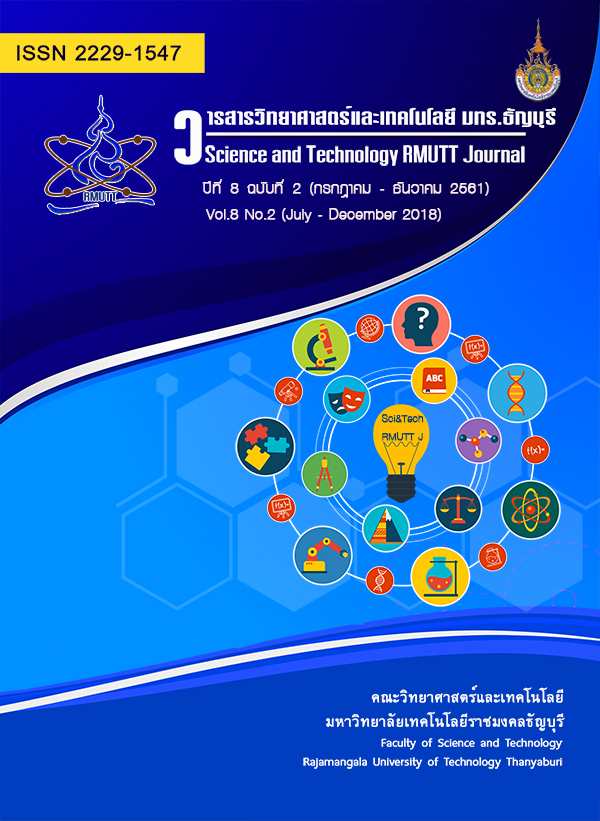Total phenolic content and anti-radical activity of stingless bee honey at different harvesting times
Main Article Content
Abstract
The aim of this research was to study on total phenolic content and anti-radical activity of stingless bee honey from three stingless bee species (Geniotrigona thoracica, Heterotrigona itama and Tetragonular larviceps). The samples were harvested 6 times for a period of 1 year. It was found that the total phenolic contents of G.thoracica, H.itama and T.larviceps were in range from 30-500, 90-600 and 50-1,000 mg GAE/100 honey, respectively at the different times of harvesting. In October to November, all stingless bee species gave the lowest content of total phenolic compounds. In addition, T.larviceps had the highest content of total phenolic compounds during in June to July and August to September. The IC50 concentration for anti-radical activity ranged from 25-85, 11-27 and 11-17 mg/mL of G.thoracica, H.itama and T.larviceps, respectively. The data indicated that the honey of T.larviceps showed the best of anti-radical activity. Its IC50 values were similar throughout the year.
Article Details
References
ณัฏฐ์พัชร เถียรวรกานต์ กังสดาล กนกหงษ สมใจ ปงหาญ อารีรักษ์ วิชัยศร และกิตติชัย เกตุจิ๋ว. รายงานผลบริการวิชาการ เรื่องฐานเรียนรู้ผึ้งชันโรง มหาวิทยาลัย แม่โจ้. คณะผลิตกรรมการเกษตร มหาวิทยาลัยแม่โจ้, เชียงใหม่. 2560: 38-40
Rao P.V., Krishnana K.T., Sallehb N. and Gan S.H. Biological and therapeutic effects of honey produced by honey bees and stingless bees: a comparative review. Revista Brasileira de Farmacognosia. 2016. 26: 657-664.
Almeida da Silva I.A., Sarmento da Silva T.M., Camara C.A., Queiroz N., Magnani M., Santos de Novais J., L.E.B. Soledade de Oliveira Lima E., Lucia de Souza A. and Gouveia de Souza, A. Phenolic profile, antioxidant activity and palynological analysis of stingless bee honey from Amazonas, Northern Brazil. Food Chemistry. 2013. 141: 3552-3558.
Oddo L.P., Heard T.A., Rodríguez-Malaver A., Pérez R. A., Fernández-Muiño M., Sancho M. T., Sesta G., Lusco L. and Vit P. Composition and Antioxidant Activity of Trigona carbonaria Honey from Australia. Journal of Medicinal Food. 2008. 11: 789–794.
Krishnasree V. and Ukkuru P.M. Phytochemical screening and antioxidant activity of different bee honeys. Journal of Medicinal Herbs and Ethnomedicine. 2015. 1: 38-44.
Abu Bakar M.F., Sanusi S.B., Abu Bakar F.I., Cong O.J. and Mian Z. Physicochemical and Antioxidant Potential of Raw Unprocessed Honey from Malaysian Stingless Bees. Pakistan Journal of Nutrition. 2017. 16(11): 888-894.
Chan B.K., Haron H., Talib R.A. and Subramaniam P. Physical Properties, Antioxidant Content and Anti-Oxidative Activities of Malaysian Stingless Kelulut (Trigona spp.) Honey. The Journal of Agricultural Science. 2017. 9(13): 32-40.
Paini D.R. Impact of the introduced honey bee (Apis mellifera) (Hymenoptera: Apidae) on native bees: A review. Austral Ecology. 2004. 29: 399–407.
Vit P., Uddin J., Zuccato V., Maza F. and E. Schievano. Entomological Origin of Honey Discriminated by NMR Chloroform Extracts in Ecuadorian Honey. International Journal of Nutrition and Food Engineering. 2015. 9: 494-497.
Abu Bakar M.F., Sanusi S.B., Abu Bakar F.I., Cong O.J. and Mian Z. Physicochemical and Antioxidant Potential of Raw Unprocessed Honey from Malaysian Stingless Bees. Pakistan Journal of Nutrition. 2017. 16: 888-894.
Chan B.K., Haron H., Abdul Talib R. and P. Subramaniam. Physical Properties, Antioxidant Content and Anti-Oxidative Activities of Malaysian Stingless Kelulut (Trigona spp.) Honey. Journal of Agricultural Science. 2017. 9: 32-40.
Bendary E., Francis R.R., Ali H.M.G., Sarwat M.I. and El Hady S. Antioxidant and structure–activity relationships (SARs) of some phenolic and anilines compounds. Annals of Agricultural Sciences. 2013. 58(2): 173–181.
Wang T.-Y., Li Q. and Bi K.-S. Bioactive flavonoids in medicinal plants: Structure, activity and biological fate. Asian Journal of Pharmaceutical Sciences. 2018. 13: 12-23.


